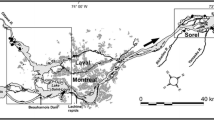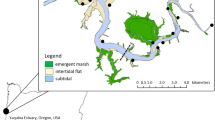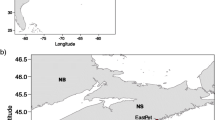Abstract
Benthic microalgae are known to perform important ecosystem functions in shallow lakes. As such it is important to understand the environmental variables responsible for regulating community structure, positioning and biomass. We tested the hypothesis that the positioning (across a depth gradient of 2–22 m overlying water depth) and relative biomass (determined using bulk and lens tissue harvested chlorophyll (Chl) a concentrations) of the epipelon community would vary independently with season (12 monthly samples) and across natural gradients of light and habitat disturbance relative to the total benthic algal community (i.e. all viable microalgae in the surface sediments) in a shallow eutrophic loch. Total sediment microalgal Chl a concentrations (TS-Chl; range: 5–874 μg Chl a g−1 dw) were highest in winter and in the deepest site (20 m overlying water depth), apparently as a result of phytoplanktonic settling and sediment focussing processes. Epipelic Chl a concentrations (Epi-Chl; range: <0.10–6.0 μg Chl a g−1 dw) were highest in winter/spring, a period when water clarity was highest and TS-Chl lowest. Principal components analysis highlighted strong associations between Epi-Chl and sites of intermediate depths (2.5–5.5 m) in all seasons except autumn/winter. Autumn/winter represented the season with the highest average wind speeds preceding sampling, during which the highest Epi-Chl concentrations were associated with the deepest sites. Epi-Chl was associated with intermediate light and habitat disturbance during spring/summer and summer/autumn and varied positively with habitat disturbance, only, in autumn/winter and winter/spring. The epipelon community structure also varied with depth; diatoms dominated shallow water sediments, cyanobacteria dominated deep water sediments, and sediments at sites of intermediate depth returned the highest biovolume estimates and the most diverse communities. This study has strengthened the hypothesis that the structure and biomass of benthic microalgal communities in lakes are regulated by habitat disturbance and water clarity, both of which are expected to respond to climate change and eutrophication. The degree to which these structural responses reflect functional performance requires clarification.








Similar content being viewed by others
References
Aberle, N. & K. Wiltshire, 2006. Seasonality and diversity patterns of microphytobenthos in a mesotrophic lake. Archiv für Hydrobiologie 167: 447–465.
Admiraal, W., 1984. The ecology of estuarine sediment-inhabiting diatoms. In Round, F. E. & D. J. Chapman (eds), Progress in Phycological Research, Vol. 3. Biopress, Bristol, UK: 269–322.
APHA, 1992. Standard Methods for the Examination of Water and Wastewater (edited by A. E. Greenberg, L. S. Clesceri & A. D. Eaton). American Public Health Association, Washington, DC.
Armitage, P., P. S. Cranston & I. C. V. Pinder, 1995. The Chironomidae: The Biology and Ecology of Non-biting Midges. Chapman & Hall, London: 572 p.
Bailey-Watts, A. E., 1974. The algal plankton of Loch Leven, Kinross. Proceedings of the Royal Society of Edinburgh B 74: 135–156.
Bailey-Watts, A. E., A. Kirika, L. May & D. H. Jones, 1990. Changes in phytoplankton over various time scales in a shallow eutrophic lake: the Loch Leven experience with special reference to the influence of flushing rate. Freshwater Biology 23: 85–111.
Bartoli, M., D. Nizzoli & P. Viaroli, 2003. Microphytobenthos activity and fluxes at the sediment–water interface: interactions and spatial variability. Aquatic Ecology 37: 341–349.
Bonilla, S., V. Villeneuve & W. F. Vincent, 2005. Benthic and planktonic algal communities in a High Arctic Lake: pigment structure and contrasting responses to nutrient enrichment. Journal of Phycology 41: 1120–1130.
Borchradt, M. A., 1996. Nutrients. In Stevenson, R. J., M. L. Bothwell & R. L. Lowe (eds), Algal Ecology: Freshwater Benthic Ecosystems. Academic Press, London, UK.
Buchaca, T. & J. Catalan, 2007. Factors influencing the variability of pigments in the surface sediments of mountain lakes. Freshwater Biology 52: 1365–1379.
Burkholder, J. M., 1996. Interactions of benthic algae with their substrata. In Stevenson, R. J., M. L. Bothwell & R. L. Lowe (eds), Algal Ecology: Freshwater Benthic Ecosystems. Academic Press, London, UK.
Calvert, S. E., 1974. The distribution of bottom sediments in Loch Leven, Kinross. Proceedings of the Royal Society of Edinburgh B 74: 69–80.
Cariou-Le Gall, V. & G. F. Blanchard, 1995. Monthly HPLC measurements of pigment concentration from an intertidal muddy sediment of Marennes-Oleraon Bay, France. Marine Ecology Progress Series 121: 171–179.
Carlton, R. G. & R. G. Wetzel, 1988. Phosphorus flux from lake sediments: effects of epipelic algal oxygen production. Limnology and Oceanography 33: 562–570.
Carvalho, L., B. Dudley & A. Kirika, 2007. Loch Leven 2004–2006: physical, chemical, and algal aspects of water quality. Report to Scottish Natural Heritage, Centre for Ecology and Hydrology, Edinburgh.
Cattaneo, A., 1987. Periphyton in lakes of different trophy. Canadian Journal of Fisheries and Aquatic Sciences 44: 296–303.
Cyr, H., 1998. How does the vertical distribution of chlorophyll vary in littoral sediments of small lakes? Freshwater Biology 39: 25–40.
Dodds, W. K., 2003. The role of periphyton in phosphorus retention in shallow freshwater aquatic systems. Journal of Phycology 39: 840–849.
Eaton, J. W. & B. Moss, 1966. The estimation of numbers and pigment content in epipelic algal populations. Limnology and Oceanography 11: 379–382.
Falkowski, P. G. & J. LaRoche, 1991. Acclimation to spectral irradiance in algae. Journal of Phycology 27: 8–14.
Fee, E. J., R. E. Hecky, S. J. Guildford, C. Anema, D. Mathew & K. Hallard, 1988. Phytoplankton primary production and related limnological data for lakes and channels in the Mackenzie Delta and lakes of the Tuktoyaktuk peninsula, NWT. Canadian Technical Report of Fisheries and Aquatic Sciences: 1614.
Gerbersdorf, S. U., T. Jancke, B. Westrich & D. M. Paterson, 2008. Microbial stabilization of riverine sediments by extracellular polymeric substances. Geobiology 6: 57–69.
Håkanson, L., 1982. Bottom dynamics in lakes. Hydrobiologia 91: 9–22.
Happey-Wood, C. M., 1988. Vertical-migration patterns of flagellates in a community of freshwater benthic algae. Hydrobiologia 161: 99–123.
Happey-Wood, C. M., G. M. A. Kennaway, M. H. Ong, A. M. Chittenden & G. Edwards, 1988. Contributions of nano- and pico-plankton to the productivity of phytoplankton and epipelic algae in an upland Welsh Lake. In Round, F. E. (ed.), Algae and the Aquatic Environment. Biopress, Bristol: 168–184.
Head, R. M., R. I. Jones & A. E. Bailey-Watts, 1999. An assessment of the influence of recruitment from the sediment on the development of planktonic populations of cyanobacteria in a temperate mesotrophic lake. Freshwater Biology 41: 759–769.
Hickman, M. & F. E. Round, 1970. Primary production and standing crops of epipsammic and epipelic algae. British Phycological Journal 5: 247–255.
Hillebrand, H., C.-D. Dűrselen, D. Kirschtel, U. Pollingher & T. Zohary, 1999. Biovolume calculation for pelagic and benthic microalgae. Journal of Phycology 35: 403–424.
Hilton, J., P. Lishman & V. Allen, 1986. The dominant processes of sediment distribution and focussing in a small, eutrophic, monomictic lake. Limnology and Oceanography 31: 125–133.
Hoagland, K. D. & C. G. Peterson, 1990. Effects of light and wave disturbance on vertical zonation of attached microalgae in a large reservoir. Journal of Phycology 26: 450–457.
Kromkamp, J., C. Barranguet & J. Peene, 1998. Determination of microphytobenthos PSII quantum efficiency and photosynthetic activity by means of variable chlorophyll fluorescence. Marine Ecology Progress Series 162: 45–55.
Lesen, A. E., 2006. Sediment organic matter composition and dynamics in San Fransisco Bay, California, USA: seasonal variation and interactions between water-column chlorophyll and the benthos. Estuarine, Coastal Shelf Science 66: 501–512.
Palmer, J. D. & F. E. Round, 1965. Persistent, vertical migration rhythms in benthic microflora. 1. The effect of light and temperature on the rhythmic behaviour of Euglena obtusa. Journal of the Marine Biological Association of the United Kingdom 45: 567–582.
Paterson, D. M., 1989. Short-term changes in the erodibility of intertidal cohesive sediments related to the migratory behaviour of epipelic diatoms. Limnology and Oceanography 34: 223–234.
Perkins, R. G., D. M. Paterson, H. Sun, J. Watson & M. A. Player, 2004. Extracellular polymeric substances: quantification and use in erosion experiments. Continental Shelf Research 24: 1623–1635.
Perkins, R. G., J.-L. Mouget, S. Lefebvre & J. Lavaud, 2006. Light response curve methodology and possible implications in the application of chlorophyll fluorescence to benthic diatoms. Marine Biology 149: 703–712.
Ploug, H., C. Lassen & B. B. Jørgensen, 1993. Action spectra of microalgal photosynthesis and depth distribution of spectral scalar irradiance in a coastal marine sediment of Limfjorden, Denmark. FEMS Microbiology, Ecology 12: 69–78.
Poulickova, A., P. Hasler, M. Lysakova & B. Spears, 2008. The ecology of freshwater epipelic algae: an update. Phycologia 47: 437–450.
Round, F. E., 1965. The Biology of the Algae. E. Arnold, London, UK. 269 pp.
Round, F. E., 1966. Persistent, vertical-migration rhythms in benthic microflora. II. Field and laboratory studies on diatoms from the banks of the River Avon. Journal of the Marine Biological Association of the United Kingdom 46: 191–214.
Round, F. E., 1981. The Ecology of Algae. Cambridge University Press, Cambridge, UK.
Round, F. E. & J. W. Eaton, 1966. Persistent, vertical-migration rhythms in benthic microflora. III. The rhythm of epipelic algae in a freshwater pond. Journal of Ecology 54: 609–615.
Smith, I. R., 1974. The structure and physical environment of Loch Leven, Scotland. Proceedings of the Royal Society of Edinburgh B 74: 81–100.
Spears, B. M., L. Carvalho, R. Perkins, A. Kirika & D. M. Paterson, 2006. Spatial and historical variation in sediment phosphorus fractions and mobility in a large shallow lake. Water Research 40: 383–391.
Spears, B. M., L. Carvalho, R. Perkins, A. Kirika & D. M. Paterson, 2007a. Sediment phosphorus cycling in a large shallow lake: spatio-temporal variation in phosphorus pools and release. Hydrobiologia 584: 37–48.
Spears, B. M., J. Funnell, J. Saunders & D. M. Paterson, 2007b. On the boundaries: sediment stability measurement across aquatic ecosystems. In Westrich, B. & U. Forstner (eds), Sediment Dynamics and Pollutant Mobility in Rivers: An Interdisciplinary Approach. Springer, New York, USA: 68–79.
Spears, B. M., L. Carvalho, R. Perkins & D. M. Paterson, 2008. Effects of light on sediment nutrient flux and water column nutrient stoichiometry in a shallow lake. Water Research 42: 977–986.
Spears, B. M. & I. D. Jones, 2010. The long-term (1979–2005) effects of the North Atlantic Oscillation on wind-induced wave mixing in Loch Leven (Scotland). Hydrobiologia. doi:10.1007/s10750-010-0188-9.
Stevenson, R. J., 1996. An introduction to algal ecology in freshwater benthic habitats. In Stevenson, R. J., Bothwell, M. L. & R. L. Lowe (eds), Algal Ecology: Freshwater Benthic Ecosystems. Academic Press, London, UK.
Vadeboncoeur, Y. & D. M. Lodge, 2000. Periphyton production on wood and sediment: susbstratum-specific response to laboratory and whole-lake nutrient manipulations. Journal of the North American Benthological Society 19: 68–81.
Vinebrooke, R. D. & P. R. Leavitt, 1999. Differential responses of littoral communities to ultraviolet radiation in an alpine lake. Ecology 80: 223–237.
Wasmund, N., 1984. Production and distribution of the microphytobenthos in the sediment of Lake Mikolajskie. International Revue der Gesamten Hydrobiologie 69: 215–229.
Wetzel, R. G. & G. E. Likens, 2000. Limnological Analysis. Springer, New York: 429.
Woodruff, S. L., W. A. House, M. E. Callow & B. S. C. Leadbeater, 1999. The effects of biofilms on chemical processes in surficial sediments. Freshwater Biology 41: 73–89.
Acknowledgements
We would like to acknowledge the staff at the Loch Leven Fishery for their continued support and assistance. Also, Suzanne McGowan (Nottingham University), David John (The Natural History Museum, London), Brian Whitton (Durham University), David Mann (Royal Botanic Gardens, Edinburgh), Iwan Jones (CEH, Dorset), Max Bothwell (National Water Research Institute, Canada) and Konrad Wolowski (Polish Academy of Sciences, Krakow) for comments regarding epipelon sampling methodology. The authors are also extremely grateful to Alex Kirika for assistance in the field and laboratory and to Guest Editor Mariana Meerhoff and an anonymous reviewer for comments that led to the improvement of the manuscript. This research was funded by NERC (NER/S/A/2003/11324).
Author information
Authors and Affiliations
Corresponding author
Additional information
Guest editors: M. Meerhoff, M. Beklioglu, R. Burks, F. García-Rodríguez, N. Mazzeo & B. Moss / Structure and Function of World Shallow Lakes: Proceedings from the 6th Shallow Lakes Congress, held in Punta del Este, Uruguay, 23–28 November, 2008
Rights and permissions
About this article
Cite this article
Spears, B.M., Carvalho, L., Perkins, R. et al. The contribution of epipelon to total sediment microalgae in a shallow temperate eutrophic loch (Loch Leven, Scotland). Hydrobiologia 646, 281–293 (2010). https://doi.org/10.1007/s10750-010-0187-x
Published:
Issue Date:
DOI: https://doi.org/10.1007/s10750-010-0187-x




